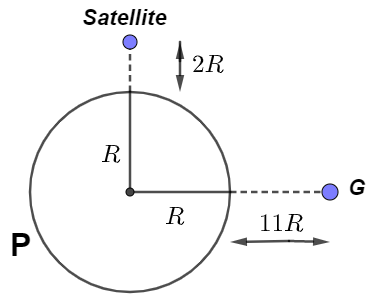
A geostationary satellite is orbiting around an arbitrary planet ‘P’ at a height of \[11R\] above the surface of ‘P’, R being the radius of ‘P’. The time period of another satellite in hours at a height of $2R$ from the surface of ‘P’ is _____. ‘P’ has a time period of rotation of $24$ hours.
(A) $\dfrac{6}{{\sqrt 2 }}$
(B) $3$
(C) $6\sqrt 2 $
(D) $5$
Answer
177.9k+ views
Hint: In order to solve this question, we will use Kepler's third law to find the relation between the time period for a geostationary satellite and the time period for given another satellite, and then, we will solve both equations to find the time period of another given satellite.
Formula used:
If T is the time period and R is the semi-major axis of an object circulating around any other celestial body such as a satellite revolving around planets is given by ${T^2} \propto {R^3}$ or $T \propto {R^{\dfrac {3}{2}}}$
Complete answer:

From the drawn diagram, we can see that G is the geostationary satellite orbiting around a planet P at a height of $11R$ which makes the semi-major axis of the satellite G is
$11R + R = 12R$
And let ‘T’ be the time period of a geostationary satellite which is $T = 24hrs$ so using Kepler's law formula ${T^2} \propto {R^3}$ we get,
${(24)^2} \propto {(12R)^3} \to (i)$
Now, for the given another satellite which is at a height of $2R$ which makes semi-major axis $2R + R = 3R$ and let ‘T’ be the time period of this satellite them again using Kepler's third law ${T^2} \propto {R^3}$ we get,
${T^2} \propto {(3R)^3} \to (ii)$
Divide equations (i) and (ii) by equating each other by removing the proportionality constant we get,
$
\dfrac{{{{(24)}^2}}}{{{{(T)}^2}}} = \dfrac{{{{(12R)}^3}}}{{{{(3R)}^3}}} \\
{(\dfrac{{24}}{T})^2} = {(4)^3} \\
T = \sqrt {\dfrac{{24 \times 24}}{{4 \times 4 \times 4}}} \\
T = 3hrs \\
$
So, the Time period of the given satellite is $3hrs$
Hence, the correct option is (B) $3$.
Note: It should be remembered that the other two laws of Kepler are such that planets revolve around the sun in an elliptical orbit having the sun as one of the foci and all planets cover the equal area in equal intervals of time while revolving around the sun.
Formula used:
If T is the time period and R is the semi-major axis of an object circulating around any other celestial body such as a satellite revolving around planets is given by ${T^2} \propto {R^3}$ or $T \propto {R^{\dfrac {3}{2}}}$
Complete answer:

From the drawn diagram, we can see that G is the geostationary satellite orbiting around a planet P at a height of $11R$ which makes the semi-major axis of the satellite G is
$11R + R = 12R$
And let ‘T’ be the time period of a geostationary satellite which is $T = 24hrs$ so using Kepler's law formula ${T^2} \propto {R^3}$ we get,
${(24)^2} \propto {(12R)^3} \to (i)$
Now, for the given another satellite which is at a height of $2R$ which makes semi-major axis $2R + R = 3R$ and let ‘T’ be the time period of this satellite them again using Kepler's third law ${T^2} \propto {R^3}$ we get,
${T^2} \propto {(3R)^3} \to (ii)$
Divide equations (i) and (ii) by equating each other by removing the proportionality constant we get,
$
\dfrac{{{{(24)}^2}}}{{{{(T)}^2}}} = \dfrac{{{{(12R)}^3}}}{{{{(3R)}^3}}} \\
{(\dfrac{{24}}{T})^2} = {(4)^3} \\
T = \sqrt {\dfrac{{24 \times 24}}{{4 \times 4 \times 4}}} \\
T = 3hrs \\
$
So, the Time period of the given satellite is $3hrs$
Hence, the correct option is (B) $3$.
Note: It should be remembered that the other two laws of Kepler are such that planets revolve around the sun in an elliptical orbit having the sun as one of the foci and all planets cover the equal area in equal intervals of time while revolving around the sun.
Recently Updated Pages
JEE Atomic Structure and Chemical Bonding important Concepts and Tips

JEE Amino Acids and Peptides Important Concepts and Tips for Exam Preparation

JEE Electricity and Magnetism Important Concepts and Tips for Exam Preparation

Chemical Properties of Hydrogen - Important Concepts for JEE Exam Preparation

JEE Energetics Important Concepts and Tips for Exam Preparation

JEE Isolation, Preparation and Properties of Non-metals Important Concepts and Tips for Exam Preparation

Trending doubts
JEE Main 2025 Session 2: Application Form (Out), Exam Dates (Released), Eligibility, & More

JEE Main 2025: Derivation of Equation of Trajectory in Physics

Displacement-Time Graph and Velocity-Time Graph for JEE

Learn About Angle Of Deviation In Prism: JEE Main Physics 2025

Degree of Dissociation and Its Formula With Solved Example for JEE

What is Hybridisation in Chemistry?

Other Pages
NCERT Solutions For Class 11 Physics Chapter 2 Motion In A Straight Line - 2025-26

NCERT Solutions For Class 11 Physics Chapter 1 Units and Measurements - 2025-26

JEE Advanced Marks vs Ranks 2025: Understanding Category-wise Qualifying Marks and Previous Year Cut-offs

Units And Measurements Class 11 Physics Chapter 1 CBSE Notes - 2025-26

NCERT Solutions For Class 11 Physics Chapter 3 Motion In A Plane - 2025-26

Motion in a Straight Line Class 11 Physics Chapter 2 CBSE Notes - 2025-26




